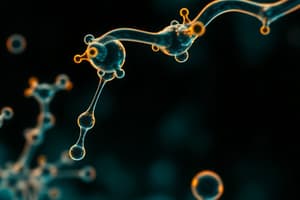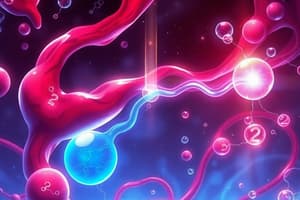Podcast
Questions and Answers
What statement best explains the difference in how pH affects the function of this enzyme?
What statement best explains the difference in how pH affects the function of this enzyme?
The enzyme is adapted for low pH but is denatured at neutral pH, leaving it nonfunctional.
Which of the following statements about the active site of an enzyme is correct?
Which of the following statements about the active site of an enzyme is correct?
- The active site is always external to the enzyme.
- The active site may resemble a groove or pocket in the surface of a protein into which the substrate fits. (correct)
- The active site is the same for all enzymes.
- The active site is located in the cytoplasm.
Which of the following is true regarding metabolic pathways?
Which of the following is true regarding metabolic pathways?
- They are always linear.
- They consist of a series of reactions, each catalyzed by a different enzyme. (correct)
- They only happen in the presence of oxygen.
- They consist of a single reaction.
Which of the following statements about enzyme function is correct?
Which of the following statements about enzyme function is correct?
The process of stabilizing the structure of an enzyme in its active form by the binding of a molecule is an example of __________.
The process of stabilizing the structure of an enzyme in its active form by the binding of a molecule is an example of __________.
Which of the following is changed by the presence of an enzyme in a reaction?
Which of the following is changed by the presence of an enzyme in a reaction?
If the entropy of a living organism is decreasing, which of the following is most likely to be occurring simultaneously?
If the entropy of a living organism is decreasing, which of the following is most likely to be occurring simultaneously?
Which of the following statements accurately defines energy coupling?
Which of the following statements accurately defines energy coupling?
ATP allosterically inhibits enzymes in ATP-producing pathways. The result of this is called __________.
ATP allosterically inhibits enzymes in ATP-producing pathways. The result of this is called __________.
Which of the following statements about enzymes is true?
Which of the following statements about enzymes is true?
Which of these statements about enzyme inhibitors is true?
Which of these statements about enzyme inhibitors is true?
How does ATP drive transport work inside a cell?
How does ATP drive transport work inside a cell?
How does ATP drive mechanical work inside a cell?
How does ATP drive mechanical work inside a cell?
Cells use ATP constantly, but ATP is considered a renewable resource. What process makes this possible?
Cells use ATP constantly, but ATP is considered a renewable resource. What process makes this possible?
Which of the following reactions would be endergonic?
Which of the following reactions would be endergonic?
Which of the following correctly states the relationship between anabolic and catabolic pathways?
Which of the following correctly states the relationship between anabolic and catabolic pathways?
Enzyme activity is affected by pH because __________.
Enzyme activity is affected by pH because __________.
What best characterizes the role of ATP in cellular metabolism?
What best characterizes the role of ATP in cellular metabolism?
Which of the following statements is correct regarding kinetic and potential energy?
Which of the following statements is correct regarding kinetic and potential energy?
An exergonic (spontaneous) reaction is a chemical reaction that __________.
An exergonic (spontaneous) reaction is a chemical reaction that __________.
Which of the following states the relevance of the first law of thermodynamics to biology?
Which of the following states the relevance of the first law of thermodynamics to biology?
Which of the following statements is correct regarding competitive and noncompetitive enzyme inhibitors?
Which of the following statements is correct regarding competitive and noncompetitive enzyme inhibitors?
Which of the following statements is correct regarding ATP?
Which of the following statements is correct regarding ATP?
What would the value of ΔS be for a chemical reaction in which a molecule is broken down into smaller components?
What would the value of ΔS be for a chemical reaction in which a molecule is broken down into smaller components?
Which of the following statements correctly describes cofactors and coenzymes?
Which of the following statements correctly describes cofactors and coenzymes?
As ATP begins to build up in a cell, metabolism slows down. How does this happen?
As ATP begins to build up in a cell, metabolism slows down. How does this happen?
An exergonic reaction __________ free energy, and an endergonic reaction __________ free energy.
An exergonic reaction __________ free energy, and an endergonic reaction __________ free energy.
At low temperatures, a particular enzyme catalyzes a reaction, but at a slow rate. At high temperatures, the enzyme is completely inactive. What statement best explains the difference in how temperature affects the function of this enzyme?
At low temperatures, a particular enzyme catalyzes a reaction, but at a slow rate. At high temperatures, the enzyme is completely inactive. What statement best explains the difference in how temperature affects the function of this enzyme?
In general, the hydrolysis of ATP drives cellular work by __________.
In general, the hydrolysis of ATP drives cellular work by __________.
Which of the following is an example of the second law of thermodynamics as it applies to biological reactions?
Which of the following is an example of the second law of thermodynamics as it applies to biological reactions?
Flashcards are hidden until you start studying
Study Notes
Enzyme Function and Regulation
- Enzymes can be highly specific to pH levels, functioning optimally at low pH while being denatured and inactive at neutral pH.
- Active sites of enzymes typically form a groove or pocket that accommodates substrates for reaction.
- Metabolic pathways involve multiple steps, with each step catalyzed by a distinct enzyme.
- Enzymes reduce activation energy needed for reactions but do not alter the equilibrium or net energy output.
- Allosteric regulation stabilizes enzymes in their active form through molecular binding.
- The presence of an enzyme specifically lowers the activation energy of chemical reactions.
Energy and Metabolism
- Decreasing entropy in an organism requires energy input to counterbalance the natural tendency towards disorder.
- Energy coupling refers to the process where exergonic reactions supply energy to drive endergonic reactions.
- ATP can inhibit enzymes in pathways that produce ATP, leading to feedback inhibition, which regulates metabolic flow.
- Enzymes increase reaction rates without changing the Gibbs free energy (ΔG) of the reaction context.
Enzyme Inhibition and Cofactors
- Enzyme inhibitors can be categorized as competitive (binding active sites) or noncompetitive (binding elsewhere), influencing enzyme activity.
- Hydrolysis of ATP releases energy by breaking down phosphate groups, driving cellular processes.
- ATP can be regenerated from ADP by adding a phosphate group, maintaining its status as a renewable energy resource.
- Coenzymes and cofactors aid enzyme function, with coenzymes being organic molecules and most cofactors being metal ions.
Thermodynamics in Biological Reactions
- Kinetic energy reflects the movement of objects, while potential energy is linked to an object's position or structure.
- An exergonic reaction is characterized by the release of energy, while an endergonic reaction absorbs energy.
- The first law of thermodynamics emphasizes that energy can transform across forms without loss, preserving the total energy.
- Examples of the second law of thermodynamics include the production of byproducts such as carbon dioxide and water in aerobic respiration.
Temperature Effects on Enzyme Activity
- Enzymes may function slowly at low temperatures due to insufficient free energy; however, at high temperatures, they can become denatured and nonfunctional.
- The hydrolysis of ATP acts as a driving force in cellular work by releasing free energy that is coupled to other biochemical reactions.
Studying That Suits You
Use AI to generate personalized quizzes and flashcards to suit your learning preferences.





